If you’re under pressure to “move the needle” in digital marketing and you’ve only got a few months’ time, paid search can be an effective way to generate bottom-line results fairly quickly. But it must be approached in a strategic manner with an eye toward long-term growth, even if the immediate goal is mere weeks away.
You Can’t Do Everything in Paid Search in 90 Days
While impressive gains can be made in a relatively short time, there are limitations on what can be accomplished. For one thing, growth can be limited by an account’s structure, especially if the account was built a long time ago or with a subpar structure. In such cases, the account would need to be fully rebuilt, which is not a quick undertaking.
Also, one of the most crucial components of paid search results usually won’t respond to improvements within 90 days. Quality Score, the valuation given by search engines to keywords used in your paid search account, can have a major financial impact. Ads with high-Quality-Score keywords rank higher and have better click-through rates, and typically result in a lower cost per click.
This one element can drive both revenue and cost savings, but it takes time for Quality Scores to improve. For a search engine to set a quality score for a keyword-ad combination, it needs data. That can happen quickly for high-traffic keywords, but for most of the keywords in your account, it will take a while.
However, you can do a lot with paid search in just one fiscal quarter, as we recently proved for a client in the fashion industry.
Understanding the Client’s Needs
This client, an online accessories retailer, approached us about growing their business through paid search. They had essentially outgrown their previous solution and were seeking more data-driven insights to help them guide marketing strategy.
Their PPC advertising activities were profitable, with a strong return on ad spend (ROAS). Their average weekly order volume was 322 and their conversion rate was 2.87%. (The click-through rate of their ads was a rather anemic .25%.) Average cost per order was $18.37 and average order value was $75.25, resulting in a 410% ROAS.
But we knew they could do better.
Immediate Fixes for Paid Search
In the first week, we blocked irrelevant keywords so the client would no longer have to pay for clicks on them, and could instead focus ad spend on keywords that are relevant to searcher intent. Impressions went down a lot (indicating how much irrelevant visibility the client was getting) and clicks decreased slightly (indicating that the client was getting some irrelevant traffic). However, because more spend went to relevant keywords, orders increased. The client’s paid search conversion rate went up to 5.03%, and ROAS soared to 1,105% in just one week.
Scaling for Growth
We started growing the client’s paid search efforts in the second week, expanding brand campaigns and writing and testing new ad copy to keep improving click-through and conversion rates.
We expanded the client’s pay per click advertising onto a new platform, creating an account in Bing Ads and launching search campaigns. In their Google account, we launched Dynamic Search Ad campaigns to improve query matching and increase click-through rate (CTR).
When the client’s Shopping ad feed experienced technical glitches, we made the most of it by launching an improved feed of Product Listing Ads (PLAs) to nurture more e-commerce sales.
We also began preparing for the most crucial online event in the client’s year: their big annual sale, a 4-day event with many different promotions and offers. As part of our preparations, we ran projection models to help determine how to allocate spend.
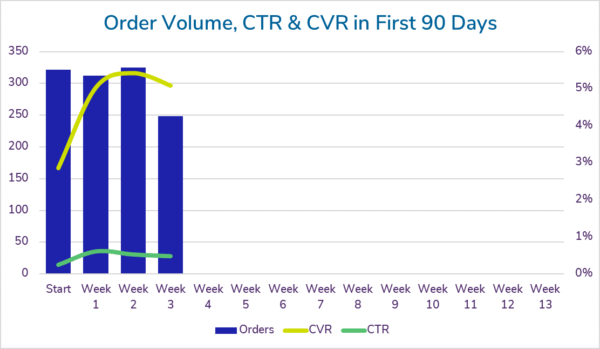
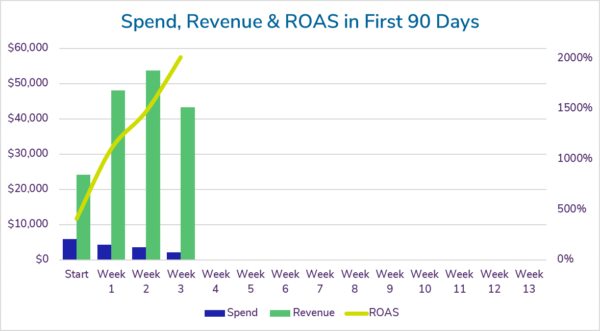
The Power of Negative Placements
In the sixth week, we optimized the sitelinks in the client’s paid search ads to promote the highest-performing search queries, while continuing to optimize bids manually. We also connected the client’s analytics platforms to their paid search accounts for more accurate tracking.
Having gotten enough data to review the placements made by programmatic partners, we added negative placements to the account. Doing so reduced wasted spend and brand-damaging placements, funneling programmatic spend to placements that performed well.
Between weeks 3 and 7, we saw consistent growth in order volume and revenue, while maintaining an average ROAS of 1,024%.
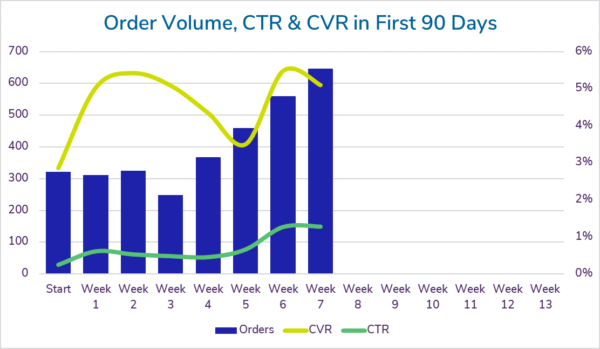
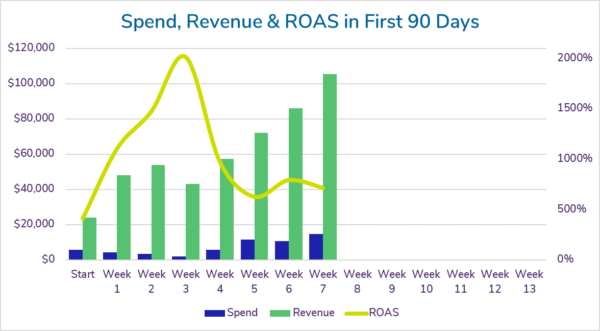
Paid Search for the Client’s Biggest Sale Event
Since the engagement began, we’d been creating and refining ads for all channels. We’d implemented audience segments to assist with ad targeting and set aside about 25% of the client’s monthly budget in preparation for this sale. With all our optimizations in place, we turned the sale ads on and kept closely monitored the results.
Our work for other clients in this space had revealed that the last day of a major sale was usually almost as profitable as the first day, so we apportioned our budget accordingly and weren’t disappointed: the final day brought in the sale’s second-highest revenue. In total, the sale brought in 816 orders at an average conversion rate of 9.87%, and $127.393 of revenue from $ 8,074 of spend, for an overall ROAS of 1,577%.
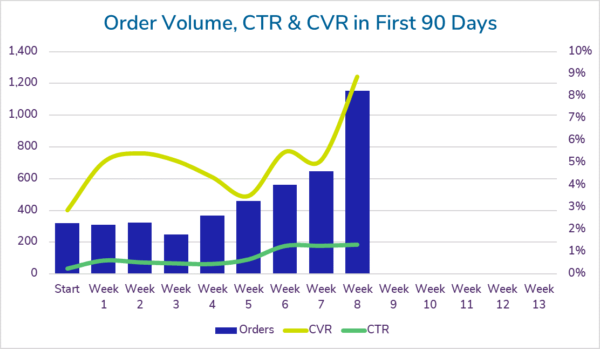
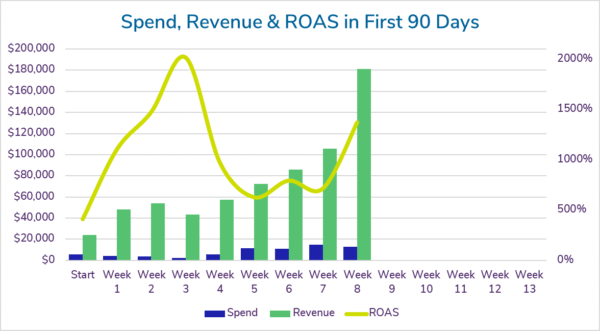
Further Scaling Paid Media
As we entered the third month of our engagement with the client, we kept applying our meticulous account management practices: testing new ad copy, finding and blocking irrelevant keywords, manually optimizing bids, and applying segmentation to audiences.
We also expanded the client’s Shopping channels to include Bing, so we could capture as wide an audience for Product Listing Ads as possible. The big sale had shown what could be accomplished in e-commerce for our client, and they wanted more.
We also adjusted bid modifiers on a device level to encourage more mobile engagement from customers while keeping mobile spend cost-effective.
Looking to the Next 90 Days
In the last few weeks of the quarter, we built dynamic prospecting campaigns to entice new customers that would begin running in the new quarter. Activities aimed at new customers always have higher costs and lower returns than customer-retention activities, but they’re absolutely essential to a business’s continued growth.
Continued growth for paid search is also essential, so we worked with the client to establish strategies and plans for the next quarter. We’re never satisfied with previous performance and we believe that there’s always room for improvement, and our plan for the next 90 days reflected that.
What Paid Search Results Did We Deliver in 90 Days?
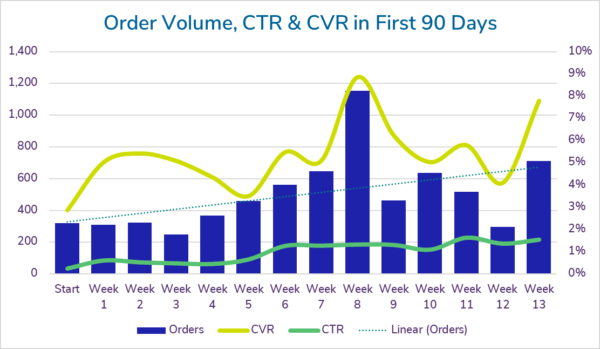
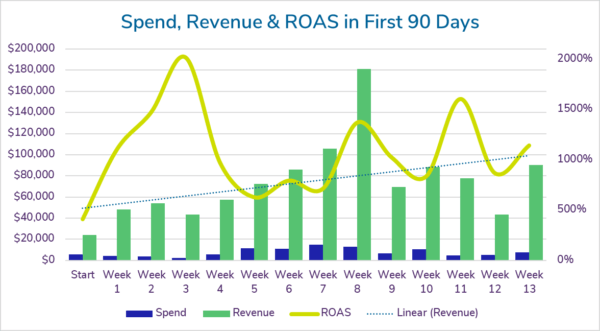
- Effective scaling: We more than doubled weekly order volume and tripled weekly revenue
- Additional scaling for ROAS: That amount of volume growth is usually accompanied by a lower ROAS, but in 90 days, the weekly ROAS went from 410% to 1,022%
- Efficient spending: We tripled weekly revenue in 90 days while increasing weekly spend by only 50%
- Record results for annual sale event: We generated so many online orders for the client that we had to pause dozens of ads because the client’s servers couldn’t keep up with the paid search traffic
Most importantly, we created a solid foundation, and not just for paid search. At (un)Common Logic, every client engagement is first and foremost a relationship. We treat our clients’ PPC investment as if it’s our own money, carefully managing it for the best possible results.
We show the same level of care through our customer service. When the client’s Shopping channels faced technical issues in Week 2, we communicated frequently with the client, keeping them up to date on any changes in the situation. When the client needed to change spending levels to accommodate new marketing projects, we responded immediately.
What kind of results would you like to get from your PPC advertising in 90 days? Let’s talk about how we can help you move the needle in just 3 months.

